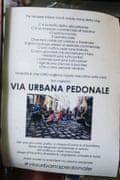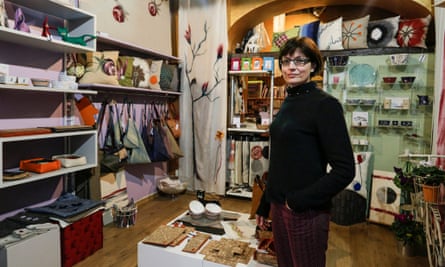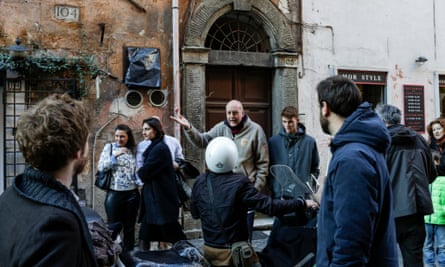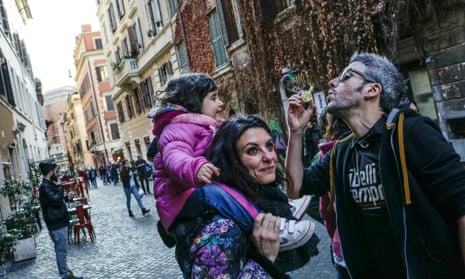Renato Gargiulo is a happy man. As president of the Urbanamente association, he has been campaigning for months to rid cars forever from Via Urbana, a beautiful cobbled street in Rome’s Monti district. The municipal council that represents all 22 rioni (districts) within the city’s ancient Aurelian walls recently voted to ban parking on the street in a move that will effectively, if not officially, pedestrianise it. Now Rome’s bicycle-friendly mayor, Ignazio Marino, has until Sunday to confirm or reject the move, but with 15 of the 19 municipal councillors voting across party lines in favour, it would appear a formality.
For the vast majority of people who live and work in Via Urbana, this is the first step in a broader campaign to change the way locals and tourists experience the city’s tight, winding vicoli (lanes) – where harrassed pedestrians are forced to dart around honking cars and buzzing scooters – and drag Rome kicking and screaming into line with the rest of 21st-century Europe.
A few days before the Municipio I’s “yes” vote, these unlikely activists held a flash-mob of pedestrians and cyclists, blocking Via Urbana to Rome’s famously aggressive scooter riders (who shouldn’t have even been able to ride up the street in the first place, as it had been officially closed to traffic for the past year while gas pipes were replaced). Gargiulo and his group wanted to make sure Via Urbana didn’t return to the chaos that previously reigned, with scooters and cars parked everywhere and pedestrians having to weave between them and the traffic.

Now the association, the first of its kind in Rome, is turning its attention to the rest of the neighbourhood, starting with Via Leonina, Via Madonna dei Monti and Via Panisperna. Could this be the beginning of a cultural shift in one of the world’s most car-dependent cities?
“We want Via Urbana to become a model not only for the rest of the rione, but for the whole of the centre of Rome,” Gargiulo said.
At the bottom of Via Urbana, flanking the modern Cavour metro station, is Piazza della Suburra, the heart of what in ancient times was a grimy, desperately poor neighbourhood – Julius Caesar’s old stomping ground. Today the area is home to a host of chic boutique shops, cafes and restaurants: a carpenter and a bespoke bike shop sit alongside a mosaic studio, which rubs up against an organic trattoria.

Since the start of the gas pipe works, these local businesses have seen a significant bump in trade. “We noticed that with the forced closure of the road, revenue has gone up 30% across the street,” said Gargiulo, who is from Naples and has lived in Rome for 25 years. “Before, with all the cars that were parked and the fear of being hit, people didn’t even see the shops. Now they do.”
Gargiulo’s association is an open group comprised, he says, of “about 90% of the local shopkeepers, but open to everyone”. In January they took a petition with 1,200 signatures (half from Monti residents) to city hall calling for the pedestrianisation of the street, and they hope that redevelopment of the area will encourage “quality tourism”, making it a place where visitors come to buy artisan goods instead of the tat that dominates much of Rome’s tourist-dominated centre.
“So many people come to this area looking for something different,” said Elena Kihlman, a Finnish designer with a hand-made fashion and furnishings shop in Via Urbana, and Gargiulo’s partner. “If you ask me, people are bored of always seeing the same stuff, regardless of what city you’re in.”
The group have some pretty heavyweight support, including the WWF, conservation group Italia Nostra and the business association Confcommercio. Mayor Marino is also a fan of pedestrian areas: he has caused serious friction with locals with his bids to cut traffic from the nearby Via dei Fori Imperiali and the Tridente area, which covers the iconic Piazza Del Popolo and Spanish Steps. The group’s key battle, it seems, will be winning over fellow Romans.
Data compiled by the Italian Automobile Club in 2011 revealed that there were just over 1.9 million cars on the road in Rome (741 for every 1,000 people), compared to just over 2.6 million cars registered in London in the same year (310 for every 1,000 people). This is partly cultural, but also due to the paucity of public transport infrastructure in Rome: an extensive tram network was dismantled in the years leading up to the 1960 Olympics, as car ownership exploded, and the city has just three metro lines, one of which is only partly finished and won’t reach the historic centre until at least 2020. According to La Repubblica, 36% of local transport company ATAC’s 2,300 buses are permanently broken down in its depots, due to debts of €429m that mean it can’t pay the companies who supply spare parts.

In such a densely populated city, finding a parking space for all these cars is a huge problem, and the authorities are known to turn a blind eye to those who double- or even triple-park outside bars and restaurants. This laissez-faire attitude suffocates tight streets such as Via Urbana, which is flanked on both sides by imposing medieval buildings. Despite the traffic ban, cars and scooters still crowd around some of the apartment buildings, and some residents have complained of having to call the traffic police just to get in or out of their homes.
“The problem is that Rome has a sick dependence on the car,” said Massimiliano Tonelli, founder of the controversial blog Roma Fa Schifo (“Rome sucks”), which regularly displays its distaste for what Romans get up to with their motors. “It’s as if there were a Constitution of Rome in which there are human rights and car rights. Taking that culture on is something the authorities need to do.”
According to Tonelli: “There are three cars to every family not because they really need them, but because they know that, regardless of the rules, they can leave it next to their front door for free. Every street has been turned into a car park. Once this is stopped, Romans’ relationship with their cars will become a healthier one.”

Urbanamente bumped up against this obstinate, overbearing attitude during their recent flash-mob protest. As the group gathered, a motorcyclist trundled up and tried to get by, outraged at the people in the way. After a brief shouting match he was allowed to whizz off, making his displeasure at this inconvenience plain for all to see, and hear.
The success of this and subsequent campaigns in changing motorists’ attitudes will go a long way to determining what kind of city Rome becomes. “Basically, the opposition wants to be able to park their car outside their front door, and that attitude that needs to change,” said Gargiulo. “The historic centre is a Unesco world heritage site: it belongs to everyone.”

Comments (…)
Sign in or create your Guardian account to join the discussion